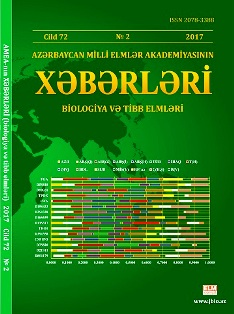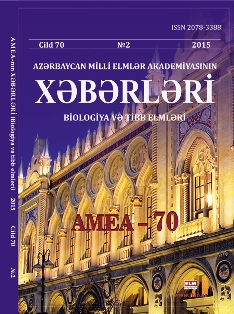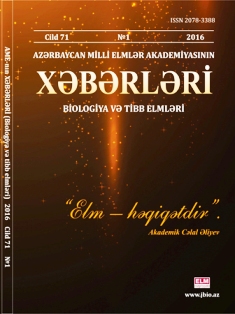
Dopplerographic and electrophysiologic studies of retinitis pigmentosa in young people
Research article: Dopplerographic and electrophysiologic studies of retinitis pigmentosa in young people
Authors: A.N. Mammadzada1*, N.I. Aliyeva1, S.N. Orujeva1, U.F. Hashimova2
1National Centre of Ophthalmology named after Academician Zarifa Aliyeva, 32/15 Javadkhan Str., Baku AZ1000, Azerbaijan
2Academician Abdulla Garayev Institute of Physiology, Azerbaijan National Academy of Sciences, 78 Sharifzadeh Str., Baku AZ1100, Azerbaijan
*For correspondence: mamedzade04@mail.ru
Accepted for publication: 22 May 2020
Abstract:
The work concerns the study of retinitis pigmentosa (RP) – a hereditary generalized retinal dystrophy. Purpose: to study the changes in hemodynamic parameters in the eye vessels and ERG indexes and to implement a correlation analysis of young patients with various stages of RP. 100 patients (200 eyes) at the age from 15 to 24 years old with RP were examined, among them 41 pati- ents – women, 59 patients – men. Patients were culled into 3 groups according to the functional di- sorders: I – 31 patients (62 eyes) with initial stage of RP, II – 40 patients (80 eyes) with medium se- vere stage of RP, III – 29 patients (58 eyes) with severe stage of RP. All patients underwent CDI on the apparatus Toshiba “NEMIO XG SSA-580A” (Japan) with ultrasound probe 8 mHz and ERG (standard combined, 30 Hz flicker, photopic) on the apparatus ROLAND CONSULT Super Color Ganz feld Q450 SC (Germany). The results of CDI and ERG indicate statistically significant chan- ges in medium severe and severe stages of RP, also point to the disorders referred to the initial sta- ge. CDI in the patients with RP allows detecting hemodynamic disorders timely. Analysis of ERG parameters indicates an impairment of photoreceptors function in parallel to ocular blood flow di- sorders. So, CDI and ERG are required for the purposes of early diagnostics and monitoring of pa- tients with RP as well as for therapeutic and preventive measures.
Keywords: Retinitis pigmentosa (RP), colour Doppler imaging (CDI), electroretinography (ERG)
REFERENCES
Gashimova N.F., Nasrullaeva M.M., Mamedova T.M., Babaeva L.A., Mirzoeva F.Kh. (2010) Issues of pathogenesis, classification and treatment of tapetoretinal abiotrophies (literature review). Ophthalmology (Baku), No. 4: 87-91.
Kasimov E.M., Mamedzade A.N. (2012) The state of eye hemodynamics in retinitis pigmentosa in adult patients. Ophthalmology (Baku), No. 1(8): 88-91.
Kiseleva T.N., Zolnikova I.V., Demenkova O.N., Ramazanova K.A. et al. (2015) Peculiarities of eye hemodynamics and retinal electrogenesis in retinitis pigmentosa. Bulletin of Ophthalmology (Moscow), No. 5: pp. 14-19.
Shamshinova A.M. (2001) Hereditary and congenital diseases of the retina and optic nerve. Moscow: 528 p.
Shchuko A.G., Malyshev V.V., Zhukova S.I. (2010) Pigmented retinal abiotrophy. Moscow: 112 p.
Akyol N., Kükner S., Celiker U., Koyu H., Lü-leci C. (1995) Decreased retinal blood flow in retinitis pigmentosa. Can J. Ophthalmol., 30(1): 28-32.
Cellini M., Strobbe E., Gizzi C., Campos E.C. (2010) ET-1 plasma levels and ocular blood flow in retinitis pigmentosa. Can. J. Physiol. Pharmacol., 88(6): 630-635.
Dolan F., Parks S., Hammer H., Keating D. (2002) The wide field multifocal electro-retinog-ram reveals retinal dysfunction in early retinitis pigmentosa. Brit. J. of Ophthalmol., 86 (4): p.480-481.
Eden M., Payne K., Combos R., Hall G., McAl-lister M. et al. (2013) Valuing the benefits of genetic testing for retinitis pigmentosa: a pilot application of the contingent valuation method. Brit. J. of Ophthalmol., 97(8): 1051-1056.
Hamblion E.L., Moore A.T., Jugnoo S. (2010) Incidence and patterns of detection and manage-ment of childhood-onset hereditary retinal disor-ders in the UK. Brit. J. Ophthalmol., №20, p.1178.
Maguire A.M., Grunwald J.E., Dupont J. (1996) Retinal hemodynamics in retinitis pig-mentosa. Am. J. Ophthalmol., 122 (4): 502-508.
Marmor M.F., Fulton F.B., Holder G.E., Mya-ke Y. et al. (2009) İS-CEV standard for full-fi-eld clinical electroretinography (2008 update). Doc. Ophthalmol., 118(1): 69-77.
Parodi M., Cicinelli M., Rabiolo A., Pierro L., Gagliardi M. Et al. (2017) Vessel density analysis in patients with retinitis pigmentosa by means of optical coherence tomography angiog-raphy. Brit. J. of Ophthalmol., 101 (4): 428-432.
Riera M., Abad-Morales V., Navarro R., Ruiz-Nogales S., Mendez-Vendrell P. et al. (2019) Expanding the retinal phenotype of RP1: from retinitis pigmentosa to a novel and singular ma-cular dystrophy. Brit. J. of Ophthalmol., 101 (8): 313-318.
Robson A., Saihan Z., Jenkins S., Fitzke F., Bird A et al. (2006) Functional characterization and serial imaging of abnormal fundus autoflu-ortescence in patients with retinitis pigmentosa and normal visual acuity. Brit. J. of Ophthal-mol., 90 (4): 472-479.
Sandberg A., Rosner B., Weigel-DiFranco C., Berson E. (2011) Lack of scientific rationale for use of valproic acid for retinitis pigmentosa. Brit. J. of Ophthalmol., 95 (5): 428-432.
Seeliger M., Kretschmann U., Apfelstedt-Sylla E., Ruther K., Zrenner E. (1998) Multifocal electroretinography in retinitis pigmentosa. Am. J. of Ophthalmol., 1998, 125 (2), p.214-226.
Steuer E., Formińska-Kapuścik M., Kamińska-Olechnowicz B. et al. (2005) Assessment of blood flow in retinal pigment degeneration. Klin. Oczna., 107 (1-3): 57-59.
Zhang Y., Harrison J., Nateras O., Chalfin S. (2013) Decreased retinal-choroidal blood flow in retinitis pigmentosa as measured by MRI. Doc. Ophthalmol., 126 (3): 187-197.























